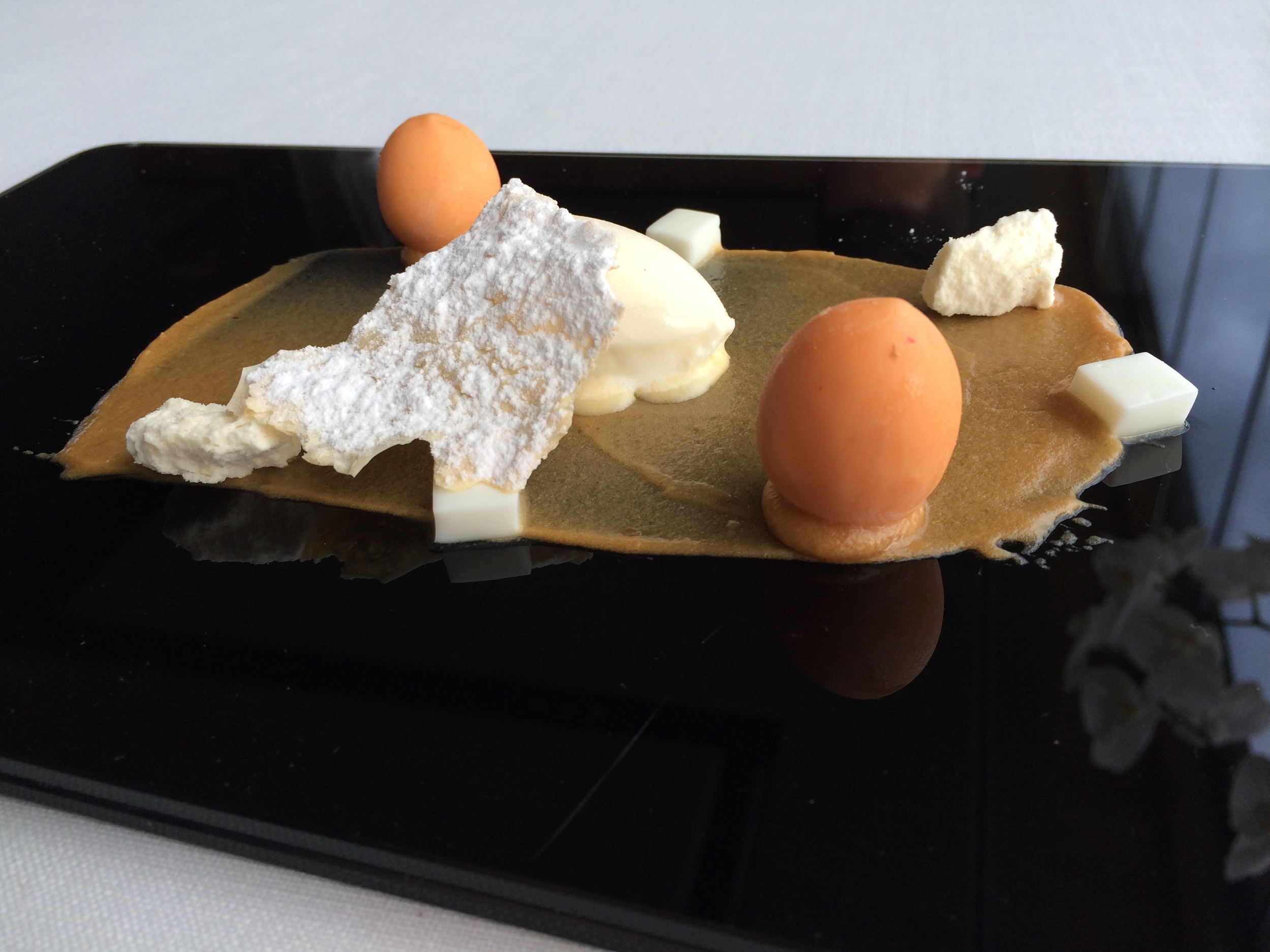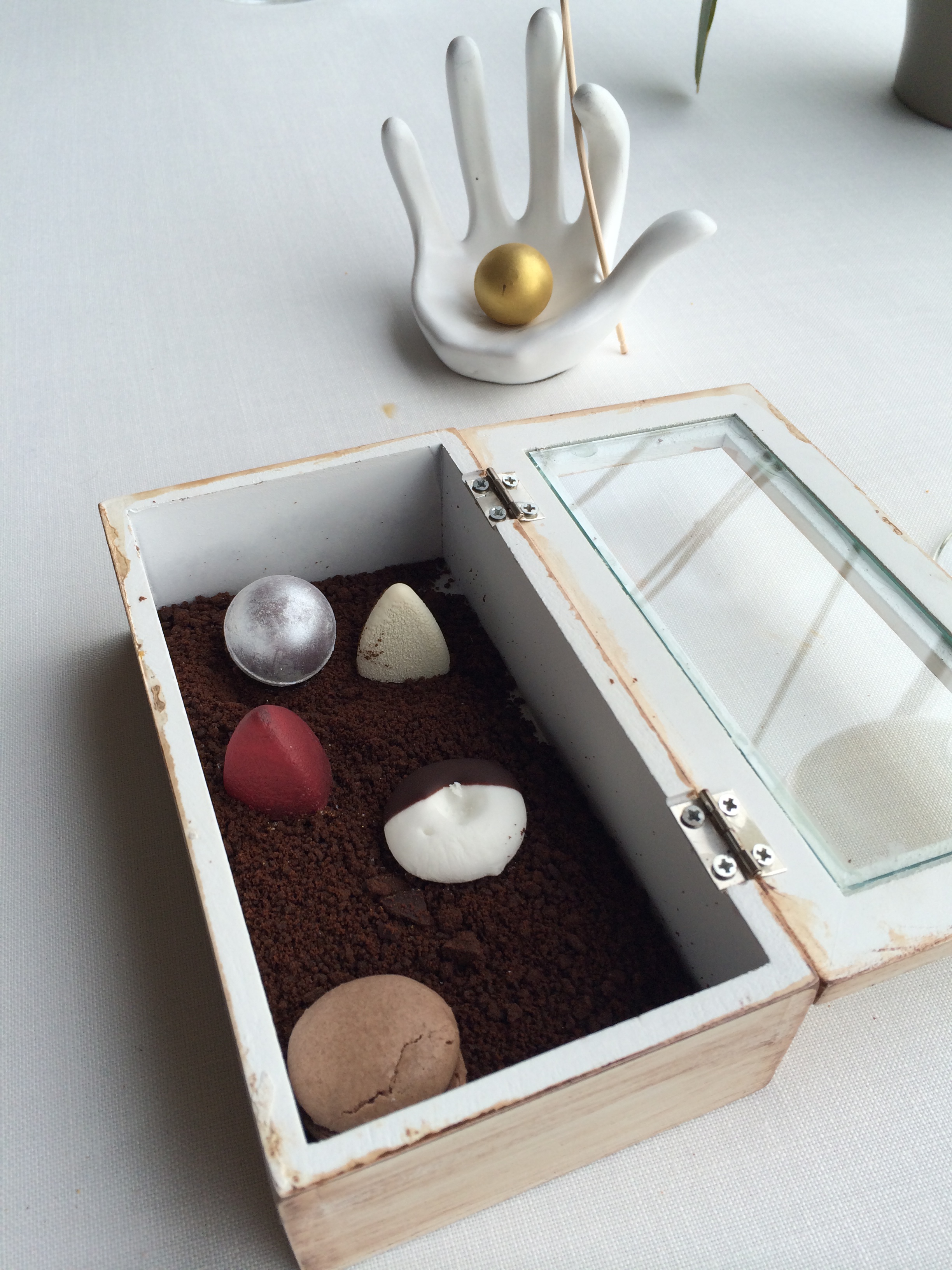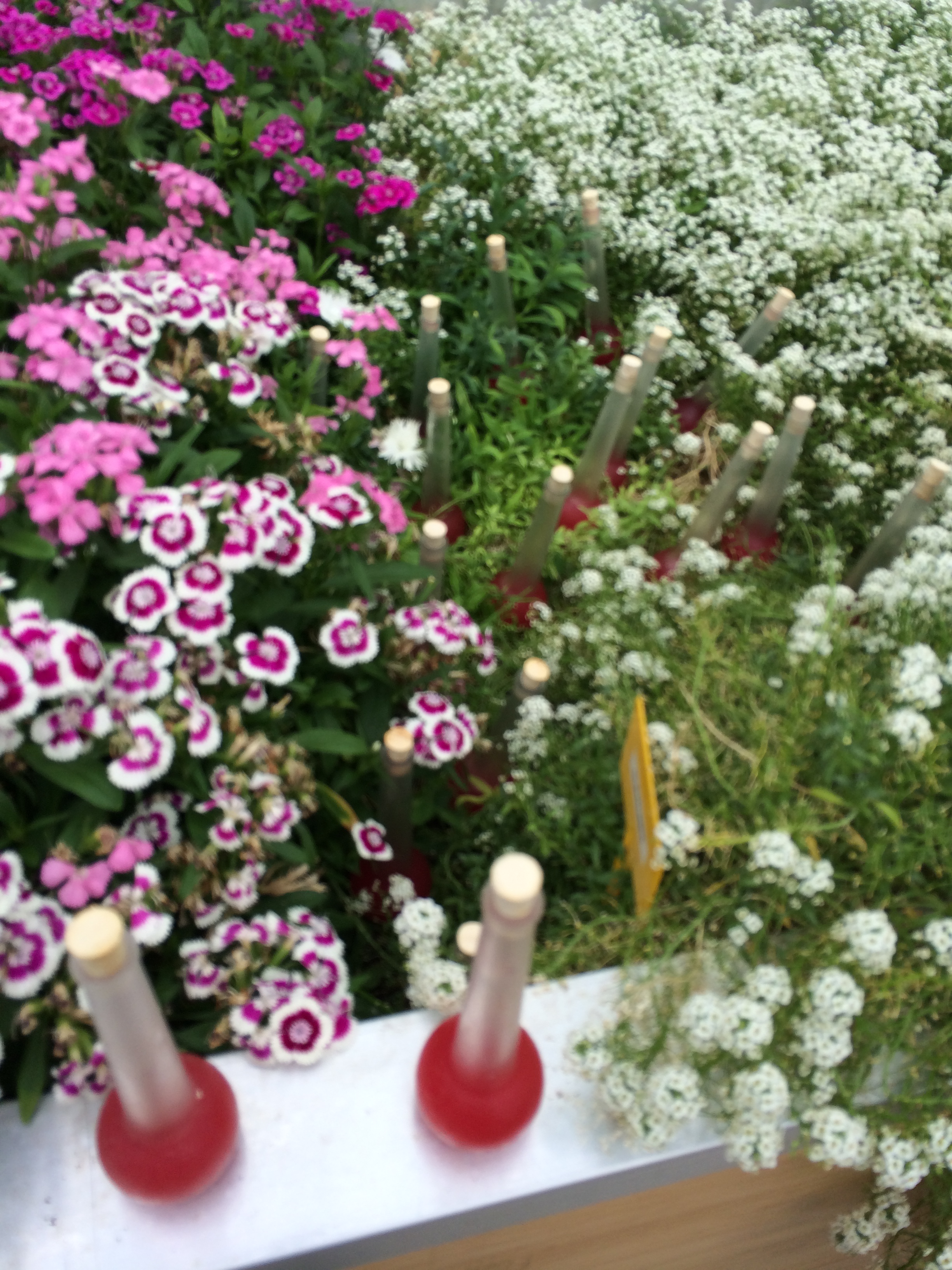From Barcelona, fly to the Basque city of Bilbao. What had been a sad and dilapidated city was given a thrust of culture, opening it to tourism that eventually made it the stunning metropolis it is today. Exiting the chic airport, you wonder if you’re still in Spain. Everything ticks forward a quarter century. The climate is cool. Lush mountains around gleaming lakes replace the red ochre of southern Spain. The language and architecture is definitively Germanic. On a speedy bus that flies through some vaulted tunnels, the first glimpse of the city is the beautiful Guggenheim museum. This bastion of modern art looks like a metallic super-ship of the future, resting on the Nervion river. It features such celebrated works as a flower-covered puppy by Jeff Koons, and Louise Bourgeois’s metal spider that also appears at Ottawa’s National Gallery and the Tate Modern. The flagship display is The Matter of Time by Richard Serra, a football field sized room with cylindrical torqued steel that patrons can walk through. The last installation, entitled Blind Spot Reversed redefines reality by playing an optical illusion on visitors who think the exhibit is over only to dig themselves deeper into the eye-shaped layout. Upstairs, a floor is dedicated to Yoko Ono, the odd widow of John Lennon who grunts and shouts songs in a fashionable top hat. In a recent performance, Ono makes bad dancing into an indigestible art piece. In a live performance in some art museum, she does a splendid and well-practiced cover of Katy Perry’s Fireworks. According to the New York Times, Ono has mastered non-existence in art in a world where there are too many people that do too many things. This is emphasized in the Bilbao exhibition: a line of gumball machines that sell air; a revolving door that has an entrance but no exit; another is simply an instruction for people to bring a container for water. A good creative one, I thought, was the sponge.
The Matter of Time, Guggenheim, Bilbao
Jeff Koons in front of the Guggenheim, Bilbao
There is also a fine arts museum, anbustling old city (“Casco Viejo”), a supercharged community centre (“Alhondiga”) and a view via the Funicular de Artxanda. But the real reason to enter the Basque country is for the food. This culinary hotspot that essentially invented molecular gastronomy punches much above its weight on every guide and ranking. 20 minutes outside of Bilbao (30€ taxi; bus requires some walking and planning) is Azurmendi, which translates literally to azure mountain. There isn’t much blue but this modernistic, mountain-top restaurant is surrounded by gardens and greenhouses. And that is where the culinary adventure begins. A chef, uniform and all, leads guests up to the seemingly magical greenhouse, where delectable amuse-bouches ‘grow’ alongside the plants that bore them. Crunchy Jerusalem artichoke chips are disguised as tree bark; vinegar-soaked carrots are planted in test tubes; orange, pomelo, hisbiscus form a citrusy juice in a corked vial; exploding skinned tomatoes go back on the vine; avocado is reconstituted to look like the pit.
Back in the main hall, a picnic basket is served with a glass of white wine. Start with a jar of salty sardines. Then a pizza pocket filled with unctuous pork fat and topped with a piece of Jamón. Finally, a ball that bursts in Caipirinha flavor. The adventure continues in the huge kitchen staffed by 18 chefs. It’s as large as the dining room, it seems. At the front is head chef Eneko Atxa, working on his new menu to be introduced the following week. I notice I had met him before at the entrance, but didn’t think much because of his earrings. Here, a few more amuse-bouches are given: a black pudding croquette and a viscous red bean soup. The ones served inside did not inspire the taste buds or the imagination, as did the ones served in the green house. Yet as we finally sat down at our table, it was already 2pm, we were impressed, yet the menu had not even started.
The options are 135€ for 10 courses or 160€ for 13. Substitutions are encouraged so choose the smaller course but pick the best things from either. There is also a wine pairing option (40-65€) but a cheap and cheery bottle of wine (22€) is the better option.
First, a trio of re-imagined nuts in molecular style. The best is hazelnut – made with foie gras shaped with dark chocolate. The flavor is intense, and keeps the intended nuttiness. To go with the nuts, the earthy flavor of mushrooms form the leaf (a maple leaf, might I add). Next is a signature Azurmendi dish: an egg yolk with insides replaced with truffle. A slight jostle and it bursts into delightful full-bodied flavours. This style of spherification is the poster child of molecular gastronomy. It was first started at elBulli (see Tickets and Bodego 1900 from Barcelona guide) and now seems to be everywhere around the world. Here, it’s an egg; at tickets, it’s an olive; at Gaggan, halfway around the world in Bangkok, it’s a yogurt lassi. Still firmly in amuse-bouche territory, I must say I am terribly amused. Next, an explosion of tomato flavor, provided by either skinned, crisped or puréed tomatoes. You might expect it to taste like a capresse salad with the cheese and basil. But the Idiazábal milk cheese is runny, much like a yogurt. It glues all the tomato components together. But why there are two of these, side by side, I do not know. Perhaps it each represents a hemisphere of the tomato. Finally, the Idiazábal milk cheese comes back in ice cream form. Think of it as the best frozen yogurt you’ve ever tasted. It’s hearty despite being cold, and not at all sweet.
The lobster on chive emulsion and oil is perfectly cooked, retaining a bounce without being too tough. Cutting through this wonderful piece, let alone eating it, is quite the experience. But the dish begins with an odd Te Maki (a hand roll) of lobster tartare that was a bit salty and didn’t seem very fine, nor did it complement the rest of the dish. Squid noodles that are only identifiable by its wrinkles have the texture of pasta. They’re made by freezing and slicing, and finally coating with a sweet squid reduction. The first off-dish was the Duck Royal “à l’orange”, a beautiful terrine of duck covered with duck sauce and foie gras coated with orange jelly with a spray of orange blossom perfume, tableside. The duck, stuck laboriously in a terrine, fails to be eventful. In a normal duck à l’orange, the heaviness of the sauce is balanced out by the medium-rare juices of the duck. Here, the duck takes a confit texture with not enough orange to bring out its oily flavours. The foie gras seemed gratuitous and made this weighty plate heavier. Then, slimy Kokotxas, or fish throat, with pommes soufflés, fails to make an impression. The recovery is the pigeon on deuxelle and truffle. This is what the duck à l’orange should have tasted more like. The pigeon was blushing pink with a crispy crust that soaked up the glimmering pigeon jus. Puréed and quartered mushrooms added some varied texture. Delicious. But the side salad of mushroom, truffles and cress was disappointing. It was flavourless except the copious amount of salt that made it a bit of an appetite killer.
Finally, some dessert. The first is a beautiful rose-themed strawberry dish. Tiny hearts of strawberry lie on strawberry sorbet and then on mushroom. The liquid nitrogen, another nouveau-cuisine fave, was added fanfare for no benefit in taste. A rose petal jutting out is beautiful but made the dish difficult to cut through. Yet it was still an excellent ode to the strawberry. Then, on a reflective black glass lay a beautiful arrangement of “egg and dairy products”. It included milk ice cream, butter toffee, exploding eggs with caramel, milk skin and jelly of yogurt. It was a fun plate that you can stuff in your mouth in whatever order and always get a different sensation, though still centered around the sweet and buttery main ingredients. It is a bit like Nomad’s famous milk and honey (see America Restaurant Guide section) and perhaps struggles to meet it. The petit fours are a cool assemblage of sweets, some placed in a box filled with chocolate crumbs. Some were rich and delicious. The balls filled with lime or lemon filling were a little too sweet and too sour. The meal ends with paying the 135€ ransom, meeting the chef (who passed on his regards for the restaurateurs of Arzak, see below) and receiving the personalized menu stamped with an Azurmendi seal.
In the final analysis, the meal is worth its weight in gold (about 165€ all in). Perhaps moreso in the experience (e.g. the garden tour; the immaculate service) but maybe not entirely in the food, which had some highlights but some disappointments as well. Especially on the first pass, it is an essential place to dine at for its beauty and philosophy. Does it need to be revisited at the going price, probably not.
Azurmendi, near Bilbao, 3 stars, 26th best restaurant in the world
Hazelnut, peanut, almond and mushroom leaf
Egg from our hens, cooked inside out and truffled
Tomato, cheese and basil tartlet
Roasted lobster out of the shell on oil herbs and sweet chives
Roasted squid on its juice and its ink sponge [originally Traditional fisherman style charcoal-grilled rice]
Duck Royal “a l’orange” and orange blossom aroma
“Kokotxas” with tomatoes
Pigeon, deuxelle and truffle
Strawberry and roses
Egg and dairy products; Farmhouse milk ice cream, butter toffee, “homemade Eggs”, milk skin and gelée of yogurt
Petits fours
135€
A bus took us to San Sebastian, the heart of Basque country and one of the first travel destinations of wealthy people, preferred for its temperate climate so the rich could wear out their best fashions. San Sebastian is still a huge tourist destination, but because of the esoteric interests it satisfies, it is unencumbered by the masses. Needless to say, the Mandarins, who have discovered Barcelona en masse, have missed this pearl only an hour away by flight. The main reason to go is, of course, for the Michelin stars. The most per capita, apparently. But before any stars, experience the run-off effect of star status on pedestrian food. The transformation is outstanding. The lowly “tapas” style of eating that has given rise to potato bravas (i.e. Spanish poutine) take on foodie status. In fact, they even have a different name. In these parts, they’re called pintxos. The best is La Cuchara de San Telmo, a narrow eatery that doesn’t have a phone number. Some star dishes are the perfectly al dente orzo mushroom risotto with a dash of goat cheese, the gargantuan slice of seared foie gras on apple compote and a beautifully pink slice of rib-eye. With drinks, it comes out to 20€. Only in San Sebastian.
La Cuchara de San Telmo
In this tiny tapas bar, foodies of all shapes and sizes rush to get a slice of Basque heaven. Of them, is Raphael, head chef of Dubai’s La Petite Maison (see Dubai guide). Out of the blue, he asked us what was good, and we recommended everything we had. We got into a foodie discussion. Three-star was not his style, he says. Instead, he prefers simple food. One small problem: Raphael owns the 81st best restaurant in the world. It is called La Petite Maison, in Dubai. I was delighted because in an attempt to cover the top 100 restaurants in the world, I had already reserved his simpleton restaurant for my short leg in Dubai. We swapped emails and he told us to arrive hungry in Dubai. Again, only in San Sebastian. His words, not mine.
The next day, in an affront to Raphael’s code, we went to Arzak. It is the most notable of all of San Sebastian’s three-stars, of which there are four. It is largely responsible for bringing Spain into the foodie spotlight, as the first restaurant to earn three stars from the French guide. Now Spain is at the forefront. Going to two three-star restaurants two days in a row might be categorized as excessive behaviour. But purpose was juxtaposition. Compared to Azurmendi, Arzak is an ugly hole in the wall. It is cramped, service is slow, there is no show-and-tell. The price is much higher at 189€, though that hasn’t stopped people from filling the restaurant completely. “Everyone in San Sebastian has been here,” proclaimed head chef Juan Mari Arzak, who runs the family affair with his daughter Elena Arzak Espina who came out to greet us.
The menu is a four-hour hostage situation, so loose belts and scarce plans are a good idea. The amuse bouches are rather anti-climactic, especially against Azurmendi’s selection. Some similarities are noticeable: thin marinated carrots with ssamjang and jamon on a stick. The jamon corks a gazpacho, though the raspberry and apple make the fruity difference. The most visually spectacular dish is the chorizo wrapped in mango soaked in citrus “tonic”. It sits in the dimpled contour on the bottom of a crushed Schweppes can. Cool. But in taste, all reliably unmemorable. The real food begins with the famous beet-dyed apple paper over foie gras. The filmy and soft apple is still texturally responsive against the creamy foie gras. Strips of orchid flower on a light pimento sauce accentuate the clever balance. Foie gras comes back indulgently in stone-shaped pockets of tea and coffee flavored caramelized onion, shaped by manioc hydrated with huitlacoche. It manages not to be over-powering. A nicely cooked lobster wears a star crepe as a crown while dipping in a pool of tomato seeds. This is Arzak at its best: the sauce is deceptively simple but works in a citrusy edge into the lobster. The next dish is probably the highlight of the meal. It’s designed to look like tomorrow’s breakfast. But the egg is slow-poached, oozing in flavor. More importantly, gargonzola is disguised as ham, and pairs with egg just as well. The fish is confidently cooked, with resplendent paper-thin veggies as sides. Even a stray pistachio packs a popping flavor. The sea bass is playfully served on a video of the sea, though it might be considered frivolous. The ribeye is especially tasty, its own fatty sweets accentuated by the paper thin caramelized vegetables and rainbow coloured couscous. The pigeon is perfectly cooked, paired with an abrasive puréed grape seeds that ran slow on the tongue. Of course, a playful stack of “seeds” lie in the background.
The dessert begins with the anticipated “big truffle”; the name is a good start. A giant asteroid-like object arrives, only to be deformed by hot chocolate poured atop tableside. The chocolate disintegrates slowly. The planned result is achieved: pieces of chocolate truffle in all sorts of sizes, lying in a puddle of syrup. This is the best chocolate dish I’ve had. To balance the sweet, a black lemon shell reveals a creamy lime-green innards – a kinder surprise in San Sebastian. Some anti-climactic, half-melted chocolate and basil ice creams are served. Thankfully, the meal is saved by some bolts and nuts of sweets organized in a “ferreteria,” a hardware store. So the most expensive meal (225€ all in) ends with a weighty bill of honour. Was it worth it?
The food, indeed, was exceptional. Unlike Azurmendi, there were no missteps. However, any exceptional moments were also rare. The taste was rarely influenced by the molecular gastronomy that has iconized Basque cuisine. Any flourishes seem to have been isolated to presentation: the range of colours, the video of the sea. Indeed, the price tag is too much for what was essentially a very tasty tasting menu. Go to Azurmendi for the experience. Or better yet, go to Narisawa in Tokyo.
Arzak, San Sebastian; 3 stars, 8th best restaurant in the world
Scorpion fish mousse with kataifi
Chorizo with tonic [mango]
Marinated anchovy and strawberry
Bitter raspberry [tomato, apple; corked by melon and hamon]
“Gilda” of carrots and ssamjang
Beet root blood apple. Apple injected with beetroot accompanied by creamy foie gras and potato “Mother of pearl”
“Cromlech” Onion coffee tea manoic
Lobster “Sea and Garden”. Grilled lobster with a crispy star shaped crepe and fresh greens [crispy cucuma]
Light ovolacto. Poached egg cooked at low temperature served with crispy milk and sacha inchi [gargonzola]
Red mullet. [miss print]
Fish steak with potatoes. Fillet of seabass lightly marinated with gin and served with several flavours of potatoes
Pigeon and seeds. Breast over a selection of dried fruits accompanied by an elaboration of seeds like pumpkin, grape or sunflower
Lamb with plaster and Jerusalem artichoke. Lamb served with roasted and plastered Jerusalem artichoke, fried manioc, and their joice
The Big Truffle. Large cocoa and sugar truffle with a creamy chocolate and carob filling
Black lemon. Crispy black lemon image with a sweet citrus cream interior sprinkled with the same fruit
Ice-cream assortment
189€
Bodegón Alejandro
It is easy to eat cheaply in San Sebastian. Bodegón Alejandro, a subterranean eatery, serves a three-course meal with wine and water for 16€ a person. It’s reliably good with a touch of fine-cuisine, like squid in murky squid ink, and streaks of strawberry reduction with yogurt and brownie chunks. At Sebastian, a seaside restaurant recommended by Raphael, fresh fish and prawns are simply cooked and adorned with lemon (~20€ each). It shows how simplicity is so underrated. For more pintxos, go to the grimy Astelena (Calle de Iñigo 1, cheap) and bite into piping hot pistachio croqueta or slurp foie gras flavoured risotto.
Sebastian
Astelena
All this gastronomical galavanting can induce guilt. So rent a bike (16E a day at Ciclos Luma) and take a tour of San Sebastian on the miles of bike paths that surround the city. Most importantly, take your bike up to Mount Igueldo via the funicular (5€) and breeze down the winding streets. Along the way, you will see the beaches, the original tourist attraction. For a tougher ride, climb to the hospital counter-clockwise and, again, breeze down the street back to city centre. Afterwards, take a boat out to Santa Clara Island. It is an uninhabited wilderness with unkempt trails and breathtaking views. Tickets are sold on the south side pier (4€). The island takes about 30 minutes to complete. Back on the mainland, the San Telmo Museoa is a trip through Basque history. The juxtaposition of the new swiss-cheese grey-washed building with the well-preserved Dominican convent is reminiscent of Basque sensibilities. Don’t miss the Sert canvasses that are fiery wallpaper for the church that show the various components of Gipuzkoa society. The art gallery is small but filled with treasures, ranging from medieval to modern art.
It is difficult to think of a destination that is so rich in art and culture, is affordable, is small and manageable yet is undiscovered by the masses. The food is the major attraction and the selection is wide enough to please any demographic (except maybe the chicken-finger gobblers). But more than that, it is a beautiful coastal city with all the modern luxuries without the quotidian stress. It feels a world away from Barcelona.








































































